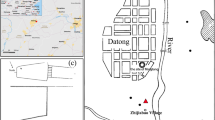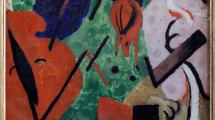Abstract
Japanese blue-and-white porcelain was developed in the Hizen area on Kyushu during the early seventeenth century and quickly shared the overseas markets with Chinese blue-and-white, which has been the favorite porcelain ware in those markets since the fourteenth century. Although most Hizen export blue-and-white imitated Chinese patterns, several visual and stylistic criteria have been identified that differentiate the productions of the two countries. Nevertheless, in archeological contexts, distinguishing blue-and-white porcelain sherds of different provenance remains a real challenge. In this paper, the chemical composition of Hizen blue-and-white porcelain sherds excavated from four sites within Spanish colonial Manila has been investigated with non-invasive portable X-ray fluorescence (pXRF) complemented with fiber optics reflectance spectroscopy (FORS). The data were compared with those obtained on samples from the two main blue-and-white porcelain production centers in China: **gdezhen and Zhangzhou. The results have revealed the characteristics of Hizen ware and shown that blue-and-white porcelain produced in Arita using the Izumiyama deposits as the raw material can be distinguished from the Chinese productions using pXRF. However, this research has also highlighted the limitations of the approach and the need for a more systematic study of the blue-and-white porcelain production from the various kiln complexes in the Hizen domain and beyond.








Similar content being viewed by others
References
Bartle EK, Watling RJ (2007) Provenance determination of oriental porcelain using laser ablation-inductively coupled plasma-mass spectrometry (LA-ICP-MS). J Forensic Sci 52:341–348
Baugh WM, Kruse FA, Atkinson WW (1998) Quantitative geochemical map** of ammonium minerals in the southern Cedar Mountains, Nevada, using the airborne visible/infrared imaging spectrometer (AVIRIS). Remote Sens Environ 65:292–308. https://doi.org/10.1016/S0034-4257(98)00039-X
Brill RH (1999) Chemical analyses of early glasses vol 2. The Corning Museum of Glass. Corning, New York
Cheng HS, Zhang B, Zhu D, Yang FJ, Sun XM, Guo MS (2005) Some new results of PIXE study on Chinese ancient porcelain. Nucl Instrum Methods Phys Res, Sect B 240:527–531
Cowell M, Zhang F (2001) Analyses and source of the cobalt-blue pigments employed on Chinese ceramics. In: Harrison-Hall J (ed) Catalogue of late Yuan and Ming ceramics in the British Museum. The British Museum Press, London, pp 601–605
De Pauw E, Tack P, Verhaeven E, Bauters S, Acke L, Vekemans B, Vincze L (2018) Microbeam X-ray fluorescence and X-ray absorption spectroscopic analysis of Chinese blue-and-white Kraak porcelain dating from the Ming Dynasty. Spectrochim Acta B At Spectrosc 149:190–196. https://doi.org/10.1016/j.sab.2018.08.006
Degawa T (2015) Imari wares in Europe. In: Weng Y-W (ed) Sailing the high seas: a special exhibition of Imari porcelain wares. National Palace Museum, Taipei, pp 302–308
Felzer B, Hauff P, Goetz AFH (1994) Quantitative reflectance spectroscopy of buddingtonite from the Cuprite Mining District, Nevada. J Geophys Res 99:2887–2895. https://doi.org/10.1029/93JB02975
Fischer C, Hsieh E (2017) Export Chinese blue-and-white porcelain: compositional analysis and sourcing using non-invasive portable XRF and reflectance spectroscopy. J Archaeol Sci 80:14–26. https://doi.org/10.1016/j.jas.2017.01.016
Fitski M (2011) Kakiemon porcelain: a handbook. Leiden University Press, Leiden
Fujian Sheng Bowuguan (1997) Zhangzhou Kilns. Fujian People Press, Fuzhou
Giannini R, Freestone IC, Shortland AJ (2017) European cobalt sources identified in the production of Chinese famille rose porcelain. J Archaeol Sci 80:27–36. https://doi.org/10.1016/j.jas.2017.01.011
Hidaka M, Horiuchi H, Ohashi K, Wijesundera RP, Kumara LSR, Sung NE (2009) Structural properties of the red-color overglazes on the Kakiemon-style porcelains produced in the later 17th century by means of X-ray diffraction (I). Cerâmica 55:120–127
Higashi S (2000) Ammonium-bearing mica and mica/smectite of several pottery stone and pyrophyllite deposits in Japan: their mineralogical properties and utilization. Appl Clay Sci 16:171–184. https://doi.org/10.1016/S0169-1317(99)00052-6
History and Folklore Museum of Arita (2013) Arita ceramics that Asia first encountered- centered on the Gamō collection. History and Folklore Museum of Arita, Arita
Hirasawa K, Uehara S (1999) Hydrothermal history of the Izumiyama pottery stone deposit inferred from microtexture and microstructure analysis of Illite by SEM and TEM. In: Resource geology-special issue 20, pp 113–122
Hoang N, Itoh J, Uto K, Matsumoto A (2007) Geochemical and Sr-Nd-Pb isotopic study of late Neogene volcanic rocks from the Arita-Imari area (SW Japan): evidence for coexisting OIB-like and subduction-related mantle sources. Adv Geosci 13:31–55
Hsieh M-l (2015) Imari wares for the Qing Imperial court. In: Weng Y-W (ed) Sailing the high seas: a special exhibition of Imari porcelain wares. National Palace Museum, Taipei, pp 321–332
Hsieh E (2017) Early Spanish colonialism in Manila, the Philippines: An historical archaeological viewpoint. UCLA dissertation
Impey O (2002) Japanese export porcelain: Catalogue of the collection of the Ashmolean Museum, Oxford. Hotei, Amsterdam
Impey O (2004) The origins of blue and white in Japan. Transactions of the Oriental Ceramic Society 67:79–84
Jiang X, Ma Y, Chen Y, Li Y, Ma Q, Zhang Z, Wang C, Yang Y (2018) Raman analysis of cobalt blue pigment in blue and white porcelain: a reassessment. Spectrochim Acta A Mol Biomol Spectrosc 190:61–67. https://doi.org/10.1016/j.saa.2017.08.076
Kajihara S, Hidaka M, Wijesundera RP, Kumara LSR, Koga M, Kobayashi S, Tsuru T, Koga K, Shimomura K, Choi J-y, Sung NE, Park YJ (2008) Correlation between the Izumiyama porcelain ceramics and the red-overglaze enamels of the Kakiemon-style porcelains. Ceram Int 34:1681–1689. https://doi.org/10.1016/j.ceramint.2007.05.017
Katsuki H, Kamochi N, Shiraishi A, Cho W, Pee J-w, Kim K-j, Choi E-s, Carty WM (2011) Some properties of the early Arita celadon. J Ceram Soc Jpn 119:672–676
Kerr R, Wood N (2004) Part XII: Ceramic technology vol 5 Chemistry and chemical technology. Science and civilization in China. Cambridge University Press, Cambridge
Kuwahara Y, Uehara S (2008) AFM study on surface microtopography, morphology and crystal growth of hydrothermal illite in Izumiyama pottery stone from Arita, Saga Prefecture, Japan. The Open Mineralogy Journal 2:34–47
Kyushu Ceramic Museum (ed) (2007) The ways to study the Old Imari: Kiln Packing. Kyushu Ceramic Museum, Saga
Nagatake T (2003) Classic Japanese Porcelain: Imari and Kakiemon. Kodansha International, Tokyo/NewYork/London
Nakagawa M (1994) Clay mineral associations and mineralogical properties of quartz in some pottery stones of Western Kyushu, Japan. Appl Clay Sci 8:331–347
Nakagawa M, Nakamoto J, Yoshihara T (1995) Hydrothermal alteration at the Izumiyama pottery stone deposit, Saga Prefecture- mineralogical properties of quartz and NH4- bearing sericite. J Clay Sci Soc Jpn 35:1–14
Nakano Y (2016) The production and distribution of Hasami ware during the early modern period. In: Sasaki T (ed) The archaeology of medieval and early modern ceramics, vol 2. Yuzankaku, Tokyo, pp 35–50
Ninomiya S, Habu J, Ohashi K, Warashina M, Aboshi M, Osawa M, Nagasako S (1991) Provenance studies of porcelain sherds excavated from early Edo period sites in Japan. Trade Ceramic Studies 11:201–234
Nogami T (2006) On Hizen porcelain and the Manila - Acapulco galleon trade. IPPA Bulletin 26:124–130
Nogami T (2013a) The Spanish galleon trade and Hizen ceramics: Japanese ceramics that traversed two oceans. Oriental Ceramics 42:141–176
Nogami T (2013b) Japanese porcelain in the Philippines. Philipp Q Cult Soc 41:101–121
Nogami T (2016) Galleon trade and Chinese ceramic. Oriental Ceramic 45:59–79
Nogami T (2017) The trade networks of Japanese porcelain in the Asia-Pacific region. In: Berrocal MC, Tsang C-h (eds) Historical archaeology of early modern colonialism in Asia-Pacific-the Asia Pacific region. University Press of Florida, Gainesville, pp 186–218
Nogami T, Orogo AB, Cuevas NT, Tanaka K (2005) Report of the research about ceramics found at Intramuros, Manila : Abstract. Archaeol J Kanazawa Univ 51:5–9
Nogami T, Ronquillo WP, Orogo AB, Cuevas NT, Tanaka K (2006) Porcelains from Manila in Spanish Philippines. Kanazawa Univ Archaeol Report 28:29–60
Ohashi K (1993) Hizen Ceramics. New Science, Tokyo
Ohashi K (2010) The Hizen wares abroad in the 17th and 18th centuries. Field Archaeology of Taiwan 13:33–48
Ohashi K (2016) The distribution of Hizen porcelain exceeding the amount of Chinese porcelain, the second half of the 17th century. In: Sasaki T (ed) The archaeology of medieval and early modern ceramics, vol 4. Yuzankaku, Tokyo, pp 63–84
Pollard M (1983) Description of method and discussion of results. Trade Ceramic Studies 3:145–158
Rotondo-McCord L, Bufton P (1997) Imari: Japanese porcelain for European palaces: from the Freda and Ralph Lupin collection. New Orleans Museum of Art, New Orleans
Rousmaniere NC (2012) Vessels of influence: China and the birth of porcelain in medieval and early modern Japan. Bristol Classical Press, London
Sakai T (2004) Development of Hizen porcelain (Imari ware) and some finding data for the Asian ceramic trade on late of the 17th century. Field Archaeology of Taiwan 9:1–18
Sakai T, Ohashi K (2017) Hizen wares excavated from royal capital sites in Indonesia: Trowulan and other sites. Yuzankaku Pub, Tokyo
Sakuraba M (2014) The Chinese junks’ interemediate trade network in Japanese porcelain for the West. In: van Campen J, Eliëns T (eds) Chinese and Japanese porcelain for the Dutch Golden Age. Waanders Uitgevers, Zwolle pp 109–128
Shortland A, Rogers N, Eremin K (2007) Trace element discriminants between Egyptian and Mesopotamian Late Bronze Age Glasses. J Archaeol Sci 34:781–789
Simpson MP (2015) Reflectance spectrometry [SWIR] of alteration minerals surrounding the Favona epithermal vein. Waihi vein system, Hauraki goldfield. In: AusIMM New Zeeland branch annual conference, Dunedin, New Zeeland, 30 August - 2 September 2015. pp 490–499
Society of Kyushu Early Modern Ceramic Study (2010) Hizen ceramic exported all over the world. Society of Kyushu early modern ceramic study, Saga
Suzuta Y (2015) The history and characteristics of Imari porcelain. In: Weng Y-W (ed) Sailing the high seas: a special exhibition of Imari porcelain wares. National Palace Museum, Taipei, pp 309–320
Takeuchi K, Kisu K (2011) Chemical composition and chronological change of Hasami ceramic body. In: Nagasaki Prefectural University-Industry Cooperation Team (ed) Hasami’s challenge- toward a regional brand. Nagasaki News, Nagasaki, pp 155–166
Viallé C (2000) Japanese porcelain for the Netherlands: the records of the Dutch East India Company. In: Kyushu Ceramic Museum (ed) The voyage of Old-Imari Porcelain. Saga Art & Culture Foundation, Saga, pp 166–183
Wagner B, Nowak A, Bulska E, Hametner K, Günther D (2012) Critical assessment of the elemental composition of corning archeological reference glasses by LA-ICP-MS. Anal Bioanal Chem 2012:1667–1677
Wang T, Zhu TQ, Feng ZY, Fayard B, Pouyet E, Cotte M, De Nolf W, Salomé M, Sciau P (2016) Synchrotron radiation-based multi-analytical approach for studying underglaze color: the microstructure of Chinese Qinghua blue decors (Ming Dynasty). Anal Chim Acta 928:20–31. https://doi.org/10.1016/j.aca.2016.04.053
Watt JCY (1979) Notes on the use of cobalt in later Chinese ceramics. Ars Orientalis 11:63–85
Wen R, Wang CS, Mao ZW, Huang YY, Pollard AM (2007) The chemical composition of blue pigment on Chinese blue-and-white porcelain of the Yuan and Ming dynasties (AD 1271-1644). Archaeometry 49:101–115
Zhang F, Cowell M (1989) The sources of cobalt blue pigment in ancient China. Sciences of Conservation and Archaeology 1:23–27
Acknowledgments
We thank the National Museum of the Philippines and the History and Folklore Museum of Arita for their support and access to materials, as well as Dr. Min Li for providing samples for this research. We also thank Christopher Shaffer from Thermo Fisher Scientific for the XRD analysis of the Izumiyama samples.
Funding
This study was supported by a Hiroshi Wagatsuma Graduate Fellowship, Asia Institute, University of California, Los Angeles.
Author information
Authors and Affiliations
Corresponding author
Additional information
Publisher’s note
Springer Nature remains neutral with regard to jurisdictional claims in published maps and institutional affiliations.
Rights and permissions
About this article
Cite this article
Hsieh, E., Fischer, C. Japanese or Chinese? Non-invasive analysis of East Asian blue-and-white porcelain. Archaeol Anthropol Sci 11, 5483–5497 (2019). https://doi.org/10.1007/s12520-019-00876-7
Received:
Accepted:
Published:
Issue Date:
DOI: https://doi.org/10.1007/s12520-019-00876-7




